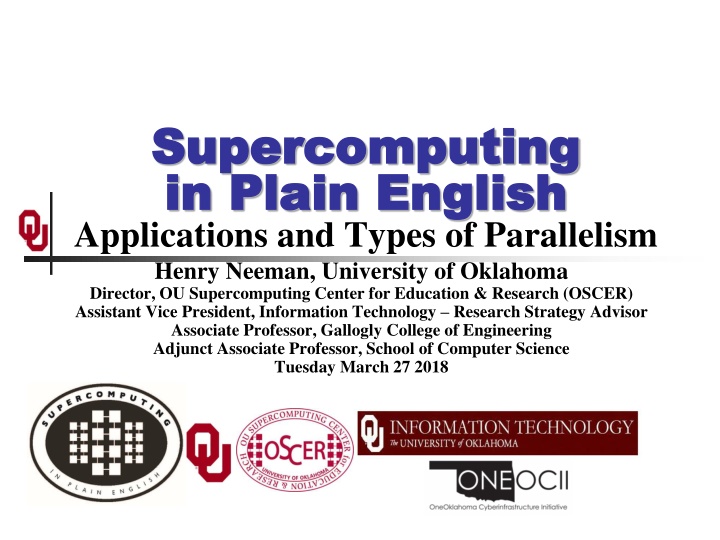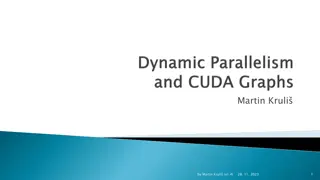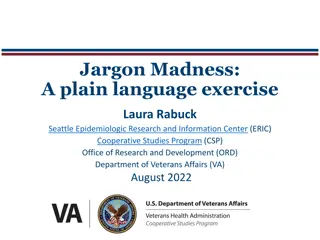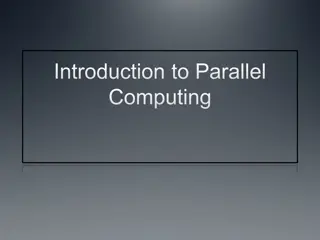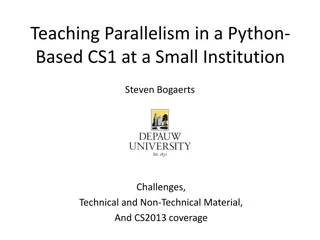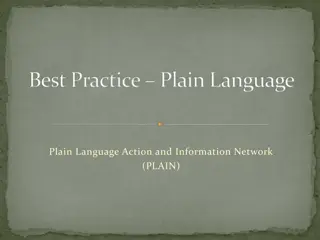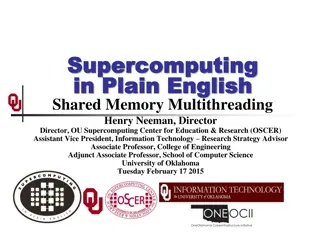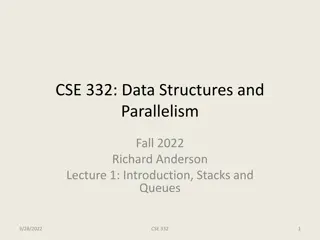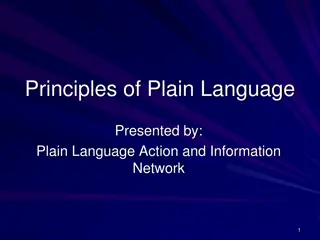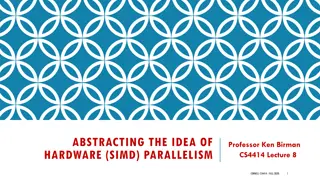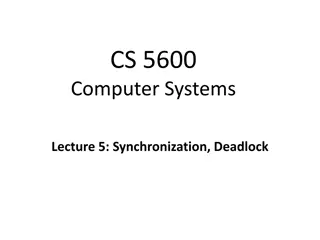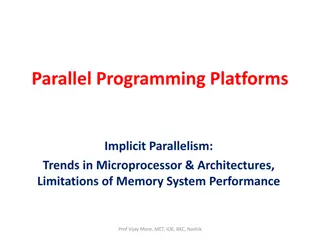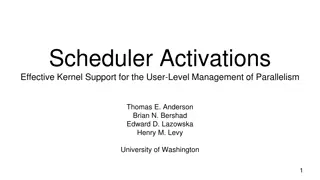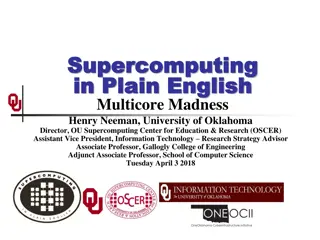Supercomputing in Plain English: Applications and Types of Parallelism
Explore the world of supercomputing with Henry Neeman from the University of Oklahoma. Join this informative session to learn about applications and types of parallelism in plain English. Remember to download the slides beforehand and mute yourself during the session for an optimal experience. Find out more about this exciting event on March 27, 2018.
Download Presentation

Please find below an Image/Link to download the presentation.
The content on the website is provided AS IS for your information and personal use only. It may not be sold, licensed, or shared on other websites without obtaining consent from the author.If you encounter any issues during the download, it is possible that the publisher has removed the file from their server.
You are allowed to download the files provided on this website for personal or commercial use, subject to the condition that they are used lawfully. All files are the property of their respective owners.
The content on the website is provided AS IS for your information and personal use only. It may not be sold, licensed, or shared on other websites without obtaining consent from the author.
E N D
Presentation Transcript
Supercomputing Supercomputing in Plain English in Plain English Applications and Types of Parallelism Henry Neeman, University of Oklahoma Director, OU Supercomputing Center for Education & Research (OSCER) Assistant Vice President, Information Technology Research Strategy Advisor Associate Professor, Gallogly College of Engineering Adjunct Associate Professor, School of Computer Science Tuesday March 27 2018
This is an experiment! It s the nature of these kinds of videoconferences that FAILURES ARE GUARANTEED TO HAPPEN! NO PROMISES! So, please bear with us. Hopefully everything will work out well enough. If you lose your connection, you can retry the same kind of connection, or try connecting another way. Remember, if all else fails, you always have the phone bridge to fall back on. PLEASE MUTE YOURSELF. PLEASE MUTE YOURSELF. PLEASE MUTE YOURSELF. Supercomputing in Plain English: Apps & Par Types Tue March 27 2018 2
PLEASE MUTE YOURSELF No matter how you connect, PLEASE MUTE YOURSELF, so that we cannot hear you. At OU, we will turn off the sound on all conferencing technologies. That way, we won t have problems with echo cancellation. Of course, that means we cannot hear questions. So for questions, you ll need to send e-mail: supercomputinginplainenglish@gmail.com PLEASE MUTE YOURSELF. PLEASE MUTE YOURSELF. PLEASE MUTE YOURSELF. Supercomputing in Plain English: Apps & Par Types Tue March 27 2018 3
Download the Slides Beforehand Before the start of the session, please download the slides from the Supercomputing in Plain English website: http://www.oscer.ou.edu/education/ That way, if anything goes wrong, you can still follow along with just audio. PLEASE MUTE YOURSELF. PLEASE MUTE YOURSELF. PLEASE MUTE YOURSELF. Supercomputing in Plain English: Apps & Par Types Tue March 27 2018 4
Zoom Go to: http://zoom.us/j/979158478 Many thanks Eddie Huebsch, OU CIO, for providing this. PLEASE MUTE YOURSELF. PLEASE MUTE YOURSELF. PLEASE MUTE YOURSELF. Supercomputing in Plain English: Apps & Par Types Tue March 27 2018 5
YouTube You can watch from a Windows, MacOS or Linux laptop or an Android or iOS handheld using YouTube. Go to YouTube via your preferred web browser or app, and then search for: Supercomputing InPlainEnglish (InPlainEnglish is all one word.) Many thanks to Skyler Donahue of OneNet for providing this. PLEASE MUTE YOURSELF. PLEASE MUTE YOURSELF. PLEASE MUTE YOURSELF. Supercomputing in Plain English: Apps & Par Types Tue March 27 2018 6
Twitch You can watch from a Windows, MacOS or Linux laptop or an Android or iOS handheld using Twitch. Go to: http://www.twitch.tv/sipe2018 Many thanks to Skyler Donahue of OneNet for providing this. PLEASE MUTE YOURSELF. PLEASE MUTE YOURSELF. PLEASE MUTE YOURSELF. Supercomputing in Plain English: Apps & Par Types Tue March 27 2018 7
Wowza #1 You can watch from a Windows, MacOS or Linux laptop using Wowza from the following URL: http://jwplayer.onenet.net/streams/sipe.html If that URL fails, then go to: http://jwplayer.onenet.net/streams/sipebackup.html Many thanks to Skyler Donahue of OneNet for providing this. PLEASE MUTE YOURSELF. PLEASE MUTE YOURSELF. PLEASE MUTE YOURSELF. Supercomputing in Plain English: Apps & Par Types Tue March 27 2018 8
Wowza #2 Wowza has been tested on multiple browsers on each of: Windows 10: IE, Firefox, Chrome, Opera, Safari MacOS: Safari, Firefox Linux: Firefox, Opera We ve also successfully tested it via apps on devices with: Android iOS Many thanks to Skyler Donahue of OneNet for providing this. PLEASE MUTE YOURSELF. PLEASE MUTE YOURSELF. PLEASE MUTE YOURSELF. Supercomputing in Plain English: Apps & Par Types Tue March 27 2018 9
Toll Free Phone Bridge IF ALL ELSE FAILS, you can use our US TOLL phone bridge: 405-325-6688 684 684 # NOTE: This is for US call-ins ONLY. PLEASE MUTE YOURSELF and use the phone to listen. Don t worry, we ll call out slide numbers as we go. Please use the phone bridge ONLY IF you cannot connect any other way: the phone bridge can handle only 100 simultaneous connections, and we have over 1000 participants. Many thanks to OU CIO Eddie Huebsch for providing the phone bridge.. Supercomputing in Plain English: Apps & Par Types Tue March 27 2018 10
Please Mute Yourself No matter how you connect, PLEASE MUTE YOURSELF, so that we cannot hear you. (For YouTube, Twitch and Wowza, you don t need to do that, because the information only goes from us to you, not from you to us.) At OU, we will turn off the sound on all conferencing technologies. That way, we won t have problems with echo cancellation. Of course, that means we cannot hear questions. So for questions, you ll need to send e-mail. PLEASE MUTE YOURSELF. Supercomputing in Plain English: Apps & Par Types Tue March 27 2018 11
Questions via E-mail Only Ask questions by sending e-mail to: supercomputinginplainenglish@gmail.com All questions will be read out loud and then answered out loud. DON T USE CHAT OR VOICE FOR QUESTIONS! No one will be monitoring any of the chats, and if we can hear your question, you re creating an echo cancellation problem. PLEASE MUTE YOURSELF. PLEASE MUTE YOURSELF. Supercomputing in Plain English: Apps & Par Types Tue March 27 2018 12
Onsite: Talent Release Form If you re attending onsite, you MUST do one of the following: complete and sign the Talent Release Form, OR sit behind the cameras (where you can t be seen) and don t talk at all. If you aren t onsite, then PLEASE MUTE YOURSELF. Supercomputing in Plain English: Apps & Par Types Tue March 27 2018 13
TENTATIVE Schedule Tue Jan 23: Storage: What the Heck is Supercomputing? Tue Jan 30: The Tyranny of the Storage Hierarchy Part I Tue Feb 6: The Tyranny of the Storage Hierarchy Part II Tue Feb 13: Instruction Level Parallelism Tue Feb 20: Stupid Compiler Tricks Tue Feb 27: Apps & Par Types Multithreading Tue March 6: Distributed Multiprocessing Tue March 13: NO SESSION (Henry business travel) Tue March 20: NO SESSION (OU's Spring Break) Tue March 27: Applications and Types of Parallelism Tue Apr 3: Multicore Madness Tue Apr 10: High Throughput Computing Tue Apr 17: NO SESSION (Henry business travel) Tue Apr 24: GPGPU: Number Crunching in Your Graphics Card Tue May 1: Grab Bag: Scientific Libraries, I/O Libraries, Visualization Supercomputing in Plain English: Apps & Par Types Tue March 27 2018 14
Thanks for helping! OU IT OSCER operations staff (Dave Akin, Patrick Calhoun, Kali McLennan, Jason Speckman, Brett Zimmerman) OSCER Research Computing Facilitators (Jim Ferguson, Horst Severini) Debi Gentis, OSCER Coordinator Kyle Dudgeon, OSCER Manager of Operations Ashish Pai, Managing Director for Research IT Services The OU IT network team OU CIO Eddie Huebsch OneNet: Skyler Donahue Oklahoma State U: Dana Brunson Supercomputing in Plain English: Apps & Par Types Tue March 27 2018 15
This is an experiment! It s the nature of these kinds of videoconferences that FAILURES ARE GUARANTEED TO HAPPEN! NO PROMISES! So, please bear with us. Hopefully everything will work out well enough. If you lose your connection, you can retry the same kind of connection, or try connecting another way. Remember, if all else fails, you always have the phone bridge to fall back on. PLEASE MUTE YOURSELF. PLEASE MUTE YOURSELF. PLEASE MUTE YOURSELF. Supercomputing in Plain English: Apps & Par Types Tue March 27 2018 16
Coming in 2018! Coalition for Advancing Digital Research & Education (CADRE) Conference: Apr 17-18 2018 @ Oklahoma State U, Stillwater OK USA https://hpcc.okstate.edu/cadre-conference Linux Clusters Institute workshops http://www.linuxclustersinstitute.org/workshops/ Introductory HPC Cluster System Administration: May 14-18 2018 @ U Nebraska, Lincoln NE USA Intermediate HPC Cluster System Administration: Aug 13-17 2018 @ Yale U, New Haven CT USA Great Plains Network Annual Meeting: details coming soon Advanced Cyberinfrastructure Research & Education Facilitators (ACI-REF) Virtual Residency Aug 5-10 2018, U Oklahoma, Norman OK USA PEARC 2018, July 22-27, Pittsburgh PA USA https://www.pearc18.pearc.org/ IEEE Cluster 2018, Sep 10-13, Belfast UK https://cluster2018.github.io OKLAHOMA SUPERCOMPUTING SYMPOSIUM 2018, Sep 25-26 2018 @ OU SC18 supercomputing conference, Nov 11-16 2018, Dallas TX USA http://sc18.supercomputing.org/ Supercomputing in Plain English: Apps & Par Types Tue March 27 2018 17
Outline Monte Carlo: Client-Server N-Body: Task Parallelism Transport: Data Parallelism Supercomputing in Plain English: Apps & Par Types Tue March 27 2018 18
Monte Carlo: Client-Server [1]
Embarrassingly Parallel An application is known as embarrassingly parallel if its parallel implementation: 1. can straightforwardly be broken up into roughly equal amounts of work per processor, AND 2. has minimal parallel overhead (for example, communication among processors). We love embarrassingly parallel applications, because they get near-perfect parallel speedup, sometimes with modest programming effort. Embarrassingly parallel applications are also known as loosely coupled. ( Embarrassingly as in an embarrassment of riches. ) Supercomputing in Plain English: Apps & Par Types Tue March 27 2018 20
Monte Carlo Methods Monte Carlo is a European city where people gamble; that is, they play games of chance, which involve randomness. Monte Carlo methods are ways of simulating (or otherwise calculating) physical phenomena based on randomness. Monte Carlo simulations typically are embarrassingly parallel. https://i1.wp.com/www.vrfitnessinsider.com/wp-content/uploads/2017/05/casino-royale.jpg?resize=1068%2C444&ssl=1 Supercomputing in Plain English: Apps & Par Types Tue March 27 2018 21
Monte Carlo Methods: Example Suppose you have some physical phenomenon. For example, consider High Energy Physics, in which we bang tiny particles together at incredibly high speeds. BANG! We want to know, for example, the average properties of this phenomenon. There are infinitely many ways that two particles can be banged together. So, we can t possibly simulate all of them. Supercomputing in Plain English: Apps & Par Types Tue March 27 2018 22
Monte Carlo Methods: Example Suppose you have some physical phenomenon. For example, consider High Energy Physics, in which we bang tiny particles together at incredibly high speeds. BANG! There are infinitely many ways that two particles can be banged together. So, we can t possibly simulate all of them. Instead, we can randomly choose a finite subset of these infinitely many ways and simulate only the subset. Supercomputing in Plain English: Apps & Par Types Tue March 27 2018 23
Monte Carlo Methods: Example Suppose you have some physical phenomenon. For example, consider High Energy Physics, in which we bang tiny particles together at incredibly high speeds. BANG! There are infinitely many ways that two particles can be banged together. We randomly choose a finite subset of these infinitely many ways and simulate only the subset. The average of this subset will be close to the actual average. Supercomputing in Plain English: Apps & Par Types Tue March 27 2018 24
Monte Carlo Methods In a Monte Carlo method, you randomly generate a large number of example cases (realizations) of a phenomenon, and then take the average of the properties of these realizations. When the average of the realizations converges (that is, doesn t change substantially if more realizations are generated), then the Monte Carlo simulation stops. Supercomputing in Plain English: Apps & Par Types Tue March 27 2018 25
MC: Embarrassingly Parallel Monte Carlo simulations are embarrassingly parallel, because each realization is completely independent of all of the other realizations. That is, if you re going to run a million realizations, then: 1. you can straightforwardly break into roughly (Million / Np) chunks of realizations, one chunk for each of the Np processors, AND 2. the only parallel overhead (for example, communication) comes from tracking the average properties, which doesn t have to happen very often. Supercomputing in Plain English: Apps & Par Types Tue March 27 2018 26
Serial Monte Carlo (C) Suppose you have an existing serial Monte Carlo simulation: int main (int argc, char** argv) { /* main */ read_input( ); for (realization = 0; realization < number_of_realizations; realization++) { generate_random_realization( ); calculate_properties( ); } /* for realization */ calculate_average( ); } /* main */ How would you parallelize this? Supercomputing in Plain English: Apps & Par Types Tue March 27 2018 27
Serial Monte Carlo (F90) Suppose you have an existing serial Monte Carlo simulation: PROGRAM monte_carlo CALL read_input( ) DO realization = 1, number_of_realizations CALL generate_random_realization( ) CALL calculate_properties( ) END DO CALL calculate_average( ) END PROGRAM monte_carlo How would you parallelize this? Supercomputing in Plain English: Apps & Par Types Tue March 27 2018 28
Parallel Monte Carlo (C) int main (int argc, char** argv) { /* main */ [MPI startup] if (my_rank == server_rank) { read_input( ); } mpi_error_code = MPI_Bcast( ); for (realization = 0; realization < number_of_realizations / number_of_processes; realization++) { generate_random_realization( ); calculate_realization_properties( ); calculate_local_running_average(...); } /* for realization */ if (my_rank == server_rank) { [receive properties] } else { [send properties] } calculate_global_average_from_local_averages( ) output_overall_average(...) [MPI shutdown] } /* main */ Supercomputing in Plain English: Apps & Par Types Tue March 27 2018 29
Parallel Monte Carlo (F90) PROGRAM monte_carlo [MPI startup] IF (my_rank == server_rank) THEN CALL read_input( ) END IF CALL MPI_Bcast( ) DO realization = 1, number_of_realizations / number_of_processes CALL generate_random_realization( ) CALL calculate_realization_properties( ) CALL calculate_local_running_average(...) END DO IF (my_rank == server_rank) THEN [receive properties] ELSE [send properties] END IF CALL calculate_global_average_from_local_averages( ) CALL output_overall_average(...) [MPI shutdown] END PROGRAM monte_carlo Supercomputing in Plain English: Apps & Par Types Tue March 27 2018 30
N-Body: Task Parallelism and Collective Communication [2]
N Bodies Supercomputing in Plain English: Apps & Par Types Tue March 27 2018 32
N-Body Problems An N-body problem is a problem involving N bodies that is, particles of some size (for example, stars, atoms) each of which applies a force to all of the others. For example, if you have N stars, then each of the N stars exerts a force (gravity) on all of the other N 1 stars. Likewise, if you have N atoms, then each atom exerts a force (nuclear) on all of the other N 1 atoms. Supercomputing in Plain English: Apps & Par Types Tue March 27 2018 33
1-Body Problem When N is 1, you have a simple 1-Body Problem: a single particle, with no forces acting on it. Given the particle s position P and velocity V at some time t0, you can trivially calculate the particle s position at time t0+ t: P(t0+ t) = P(t0) + V t V(t0+ t) = V(t0) Supercomputing in Plain English: Apps & Par Types Tue March 27 2018 34
2-Body Problem When N is 2, you have surprise! a 2-Body Problem: exactly 2 particles, each exerting a force that acts on the other. The relationship between the 2 particles can be expressed as a differential equation that can be solved analytically, producing a closed-form solution. So, given the particles initial positions and velocities, you can trivially calculate their positions and velocities at any later time. Supercomputing in Plain English: Apps & Par Types Tue March 27 2018 35
3-Body Problem When N is 3, you have surprise! a 3-Body Problem: exactly 3 particles, each exerting a force that acts on the other 2. The relationship between the 3 particles can be expressed as a differential equation that can be solved using an infinite series, producing a closed-form solution, due to Karl Fritiof Sundman in 1912. However, in practice, the number of terms of the infinite series that you need to calculate to get a reasonable solution is so large that the infinite series solution is impractical so you re stuck with the generalized formulation. http://en.wikipedia.org/wiki/N-body_problem Supercomputing in Plain English: Apps & Par Types Tue March 27 2018 36
N-Body Problems (N > 3) When N > 3, you have a general N-Body Problem: N particles, each exerting a force that acts on the other N-1 particles. The relationship between the N particles can be expressed as a differential equation that can be solved using an infinite series, producing a closed-form solution, due to Qiudong Wang in 1991.[3] However, in practice, the number of terms of the infinite series that you need to calculate to get a reasonable solution is so large that the infinite series is impractical, so you re stuck with the generalized formulation. Supercomputing in Plain English: Apps & Par Types Tue March 27 2018 37
N-Body Problems (N > 3) For N > 3, the relationship between the N particles can be expressed as a differential equation that can be solved using an infinite series, producing a closed-form solution, but convergence takes so long that this approach is impractical. So, numerical simulation is pretty much the only way to study groups of 3 or more bodies. Popular applications of N-body codes include: astronomy (that is, galaxy formation, cosmology); chemistry (that is, protein folding, molecular dynamics). Note that, for N bodies, there are on the order of N2 forces, denoted O(N2). Supercomputing in Plain English: Apps & Par Types Tue March 27 2018 38
N Bodies Supercomputing in Plain English: Apps & Par Types Tue March 27 2018 39
Force #1 A Supercomputing in Plain English: Apps & Par Types Tue March 27 2018 40
Force #2 A Supercomputing in Plain English: Apps & Par Types Tue March 27 2018 41
Force #3 A Supercomputing in Plain English: Apps & Par Types Tue March 27 2018 42
Force #4 A Supercomputing in Plain English: Apps & Par Types Tue March 27 2018 43
Force #5 A Supercomputing in Plain English: Apps & Par Types Tue March 27 2018 44
Force #6 A Supercomputing in Plain English: Apps & Par Types Tue March 27 2018 45
Force #N-1 A Supercomputing in Plain English: Apps & Par Types Tue March 27 2018 46
N-Body Problems Given N bodies, each body exerts a force on all of the other N 1 bodies. Therefore, there are N (N 1) forces in total. You can also think of this as (N (N 1)) / 2 forces, in the sense that the force from particle A to particle B is the same (except in the opposite direction) as the force from particle B to particle A. Supercomputing in Plain English: Apps & Par Types Tue March 27 2018 47
Aside: Big-O Notation Let s say that you have some task to perform on a certain number of things, and that the task takes a certain amount of time to complete. Let s say that the amount of time can be expressed as a polynomial on the number of things to perform the task on. For example, the amount of time it takes to read a book might be proportional to the number of words, plus the amount of time it takes to settle into your favorite easy chair. C1.N + C2 Supercomputing in Plain English: Apps & Par Types Tue March 27 2018 48
Big-O: Dropping the Low Term C1.N + C2 When N is very large, the time spent settling into your easy chair becomes such a small proportion of the total time that it s virtually zero. So from a practical perspective, for large N, the polynomial reduces to: C1.N In fact, for any polynomial, if N is large, then all of the terms except the highest-order term are irrelevant. Supercomputing in Plain English: Apps & Par Types Tue March 27 2018 49
Big-O: Dropping the Constant C1.N Computers get faster and faster all the time. And there are many different flavors of computers, having many different speeds. So, computer scientists don t care about the constant; they only care about the order of the highest-order term of the polynomial. They indicate this with Big-O notation: O(N), O(N2), O(N3), etc This is often said as: of order N, of order N-squared, of order N-cubed, etc. Supercomputing in Plain English: Apps & Par Types Tue March 27 2018 50
